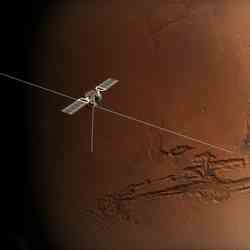

Artist’s impression of MARSIS deployment complete. Image credit: ESA Click to enlarge
MARSIS, the sounding radar on board ESA?s Mars Express spacecraft, is collecting the first data about the surface and the ionosphere of Mars.
The radar started its science operations on 4 July 2005, after the first phase of its commissioning was concluded on the same day. Due to the late deployment of MARSIS, it was decided to split the commissioning, originally planned to last four weeks, into two phases, one of which has just ended and the second one to be started by December this year.
This has given the instrument the chance to start scientific observations earlier than initially foreseen, while still in the Martian night. This is the environmental condition favourable to subsurface sounding, because the ionosphere is more ?energised? during the daytime and disturbs the radio signals used for subsurface observations.
From the beginning of the commissioning, the two 20-metre long antenna booms have been sending radio signals towards the Martian surface and receiving echoes back. ?The commissioning phase confirmed that the radar is working very well, and that it can be operated at full power without interfering with any of the spacecraft systems,? says Roberto Seu, Instrument Manager for MARSIS, from the University of Rome ?La Sapienza?, Italy.
MARSIS is a very complex instrument, capable of operating at different frequency bands. Lower frequencies are best suited to probe the subsurface and the highest frequencies are used to probe shallow subsurface depths, while all frequencies are suited to study the surface and the upper atmospheric layer of Mars.
?During the commissioning we have worked to test all transmission modes and optimise the radar performance around Mars,? says Prof. Giovanni Picardi, Principal Investigator for MARSIS, University of Rome ?La Sapienza?. ?The result is that since we have started the scientific observations in early July, we are receiving very clean surface echoes back, and first indication about the ionosphere.?
The MARSIS radar is designed to operate around the orbit ?pericentre?, when the spacecraft is closer to the planet?s surface. In each orbit, the radar has been switched on for 36 minutes around this point, dedicating the central 26 minutes to subsurface observations and the first and last five minutes of the slot to active ionosphere sounding.
Using the lower frequencies, MARSIS has been mainly investigating on the northern flat areas between 30? and 70? latitudes, at all longitudes. ?We are very satisfied about the way the radar is performing. In fact, the surface measurements taken so far match almost perfectly with the existing models of the Mars topography,? said Prof. Picardi. Thus, these measurements provided an excellent test.
The scientific reason to concentrate the first data analysis on flat regions lies in the fact that the subsurface layers here are in principle easier to identify, but the question is still tricky. ?As the radar is appearing to work so well for the surface, we have good reasons to think that the radio waves are correctly propagating also below the surface,? added Prof. Picardi.
?The biggest part of our work just started, as we now have to be sure that we clearly identify and isolate those echoes that come from the subsurface. To do this, we have to carefully screen all data and make sure that signals that could be interpreted as coming from different underground layers are not actually produced by surface irregularities. This will keep us occupied for a few more weeks at least.?
The first ionospheric measurements performed by MARSIS have also revealed some interesting preliminary findings. The radar responds directly to the number of charged particles composing the ionosphere (plasma). This has shown to be higher than expected at times.
?We are now analysing the data to find out if such measurements may result from sudden increases of solar activity, like the one observed on 14 July, or if we have to make new hypotheses. Only further analysis of the data can tell us,? said Jeffrey Plaut, Co-Principal Investigator, from NASA Jet Propulsion Laboratory, Pasadena, USA.
MARSIS will continue send signals to hit the surface and penetrate the subsurface until the middle of August, when the nighttime portion of the observations will have almost ended. After that, observation priority will be given to other Mars Express instruments that are best suited to work during daytime, such as the HRSC camera and the OMEGA mapping spectrometer.
However, MARSIS will continue surface and ionospheric investigations during daytime, with the ionospheric sounding being reserved for more than 20% percent of all Mars Express orbits, in all possible Sun illumination conditions.
In December 2005, the Mars Express orbit pericentre will enter the nighttime again. By then, the pericentre will have moved closer to the South pole, allowing MARSIS to restart optimal probing of the subsurface, this time in the southern hemisphere.
Original Source: ESA Portal
In 2015, the United Nations adopted the 2030 Agenda for Sustainable Development—the Sustainable Development Goals…
Astronomers have been battling threats to their clear skies on all fronts lately. One of…
If you were Captain of the first USS Enterprise, where would you go!? Humanity is…
Now is the best time to observe Mars in 2025. Mars from 2014. Credit: Paul…
Scheduled for launch in 2027, the Nancy Grace Roman Telescope is slowly being readied for…
Few places in the solar system are better suited to a balloon than Titan. The…